It seems like only yesterday, the milk industry was thriving. With clever “Got Milk” campaigns supported by celebrities, catchy phrases such as “Milk, It Does a Body Good,” and mom’s own nurturing beliefs that milk was necessary to build strong bones and teeth — children in the U.S. included milk, and milk products, into their diet regularly and completely.
Even the (now outdated) U.S. Food Pyramid had an entire section devoted to dairy products such as milk and cheese — a section only second in size to the carbohydrates section holding up the base of the pyramid. Indeed, milk was believed to be a vital, necessary part of the standard American diet; until now. With two large dairy companies shuttering, experienced bankruptcy lawyers wonder if this will be the next industry to topple amid a shift in consumer attitude.

Shifting Consumer Attitudes Put Pressure on Traditional Dairy
From major dairy conglomerates to small, family-run farms, milk processors are seeing their margins narrow drastically as costs climb, and consumption falls sharply due to the array of dairy-free products now available to more health-conscious, or plant-based, or anti-cruelty consumers. Just walk by the average milk section in the grocer, and you’ll see a variety of dairy-free options alongside the traditional dairy milk, including soy-milk, almond-milk, coconut-milk, hemp-milk, oat-milk, chocolate-almond-milk, and countless others.
The ice-cream section looks similar. As do all other areas of the super-market that were once dominated by dairy products, there are an array of dairy-free options now crowding the shelves.
Big Dairy Now Seeking Bankruptcy Protections
Dean Foods, the nation’s largest milk producer, filed for bankruptcy protection in November due to this new competition. And the 163-year old company continues to struggle. As for Borden, it is now the second major milk producer to seek Chapter 11 protection.
CEO at Borden, Tony Sarsam, said that the company had a growing debt burden coupled with industry headwinds, leaving them with few options moving forward. He told the Washington Post that filing for Chapter 11 was “our final resort.”
As stated, Borden has been hurt by industry trends. Last year alone, over 2,700 family dairy farms went out of business, and 94,000 farms have stopped producing milk since 1992. Borden’s bankruptcy filing states that it plans to stay in business during the bankruptcy process. In 2018, Borden had net sales of $1.2 billion, but overall, that resulted in a net loss of $14.6 million. Then, from January 2019 through December 7, 2019, Borden reported a net loss of $42.4 million.
Borden’s Long History No Match for A Shifting Industry
Borden’s history dates back all the way to before the U.S. Civil War. Its founder, Gail Borden, developed the very first successful commercial method of condensing milk in 1856. He and a business partner opened a plant in upstate New York a few years later and supplied condensed milk to the Union Army.
The company didn’t officially become known as “Borden Dairy Co.” until 1919. About a decade later, Borden had purchased over 200 other U.S. dairy companies to become the largest distributor of milk in the U.S. In 1936, the famous mascot Elsie the Cow was “born.” Elsie was the marketing darling for decades after her conception.
Borden branched into other companies, including chemicals. In 1987, it acquired 23 other companies for a total of $442.6 million. This spending led to financial struggles, and in 1995, Borden was purchased by the private equity firm Kohlberg Kravis Roberts & Co. for $2 billion. At that point, most of Borden’s non-dairy businesses were sold off.
Borden CEO Remains Optimistic
Tony Sarsam remains optimistic about Borden’s future. He pointed out that, “Companies that have had similar circumstances have gotten in and out of the filing in about six months…We expect that or faster.”





